Architectural
complex of Khodja Akhmed
Yasawi
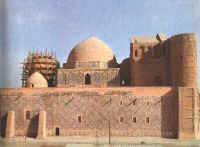 Architectural complex of Khodja Akhmed Yasawi (the end of the XIV century) - is a striking sample of the Timurid architecture. Within its structure the complex combines premises having various functions:
jamaatkhana, gurkhana (burial-vault), the major and nimor aksarais,
kitapkhana, askhana, kudukkhana and a lot of khujdras. Resulting from all these functions of the complex scientists still argue concerning its name, so it has different names: mausoleum, mosque, memorial complex,
khanaka. Each of these names emphasizes only one of the functions of this immense complex and obviously does not reflect all services and rituals foreseen by it. Recently specialists began to prefer the name "khanaka" i.e. reception houses (monasteries) for dervishes.
Architectural complex of Khodja Akhmed Yasawi (the end of the XIV century) - is a striking sample of the Timurid architecture. Within its structure the complex combines premises having various functions:
jamaatkhana, gurkhana (burial-vault), the major and nimor aksarais,
kitapkhana, askhana, kudukkhana and a lot of khujdras. Resulting from all these functions of the complex scientists still argue concerning its name, so it has different names: mausoleum, mosque, memorial complex,
khanaka. Each of these names emphasizes only one of the functions of this immense complex and obviously does not reflect all services and rituals foreseen by it. Recently specialists began to prefer the name "khanaka" i.e. reception houses (monasteries) for dervishes.
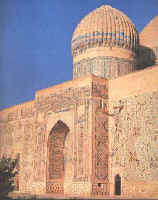 Khanaka was erected by the order of the Emir Timur in 1399 at the burial place of Khodja Akhmed
Yasawi, died in the XII century. The formal history of Timur "The Book of Victories" ("zafar-name") relates the narration about laying of this building to the events of the end of 1397, when Timur made ceremonial
(ziarat) worship on the grave of Akhmed Yasawi. According to the "Book of Victories" notably during his staying in the town of Yasy Timur ordered to erect here, on the edge of his possessions, the immense monument worthy of the memory of Khodja Akhmed
Yasawi. This monument was to glorify Islam, promote to its further dissemination, improve governing of these vast areas.
Khanaka was erected by the order of the Emir Timur in 1399 at the burial place of Khodja Akhmed
Yasawi, died in the XII century. The formal history of Timur "The Book of Victories" ("zafar-name") relates the narration about laying of this building to the events of the end of 1397, when Timur made ceremonial
(ziarat) worship on the grave of Akhmed Yasawi. According to the "Book of Victories" notably during his staying in the town of Yasy Timur ordered to erect here, on the edge of his possessions, the immense monument worthy of the memory of Khodja Akhmed
Yasawi. This monument was to glorify Islam, promote to its further dissemination, improve governing of these vast areas.
Timur himself determined the size of the erection, in particular, the diameter of the great dome had to be 30 gyazes
(gyaz - is the measure of length, equal to 60,6 cm). The Timur's order also provided the instructions concerning some decorative details of the building and its inner decoration.
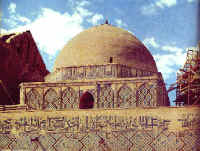 Maulyan Ubaidullakh Sadr, the person responsible for the charity matters of the Emir had to ensure implementing the order on the erection. A special deed
(vakuf-name) enumerated aryks (irrigation ditches) and lands alienated in the favor of the monument. Income derived from these possessions and donations of the faithful had to be used for the repairs of the building and keeping of the serving staff including a preacher, two Koran readers, property manager, a water- carrier, a gardener and a scavenger. Well survived inscription over the entrance to the building reads: "This sacred building has been erected by the order of the sovereign Emir Timur
Gurgan, beloved by the Allah … let Allah prolong his orders for centuries!".
Maulyan Ubaidullakh Sadr, the person responsible for the charity matters of the Emir had to ensure implementing the order on the erection. A special deed
(vakuf-name) enumerated aryks (irrigation ditches) and lands alienated in the favor of the monument. Income derived from these possessions and donations of the faithful had to be used for the repairs of the building and keeping of the serving staff including a preacher, two Koran readers, property manager, a water- carrier, a gardener and a scavenger. Well survived inscription over the entrance to the building reads: "This sacred building has been erected by the order of the sovereign Emir Timur
Gurgan, beloved by the Allah … let Allah prolong his orders for centuries!".
The Timur's orders on the erection were strictly implemented. According to the legend, when the mausoleum was being erected, along the way from khumdan (brick plant) located in Sauran to the mausoleum the workers stood in chain to hand over to each other bricks for construction. In 1405 Timur died, and the works on erection of the mausoleum of Akhmed Yasawi stopped. The portal part (peshtak) and decorating of interiors of some premises remained unfinished.
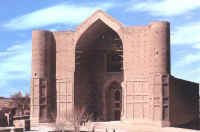 As it was mentioned above, the khanaka of Akhmed Yasawi - is a poly-functional erection including a lot of premises: djamaatkhana - a meeting hall, a burial-vault - a burial place of Akhmed Yasawi, a mosque, the major and minor aksarais - premises to hold meetings, disputes; kitabkhana- a room to make fair copies of papers, keep books and documents; askhana - a room to prepare ritual dishes; kudukkhana- a room with a well; khujdras - rooms for the serving staff of khanaka and pilgrims. Compositionally all rooms of the khanaka are combined into a quadrangle with a square about 50x60 m, and height - 15 metres. Domes and arcs of the portal rise over up to 38 metres.
As it was mentioned above, the khanaka of Akhmed Yasawi - is a poly-functional erection including a lot of premises: djamaatkhana - a meeting hall, a burial-vault - a burial place of Akhmed Yasawi, a mosque, the major and minor aksarais - premises to hold meetings, disputes; kitabkhana- a room to make fair copies of papers, keep books and documents; askhana - a room to prepare ritual dishes; kudukkhana- a room with a well; khujdras - rooms for the serving staff of khanaka and pilgrims. Compositionally all rooms of the khanaka are combined into a quadrangle with a square about 50x60 m, and height - 15 metres. Domes and arcs of the portal rise over up to 38 metres.
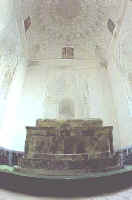 The main premises of the architectural composition of the complex is the burial-vault of Akhmed Yasawi located in the depth of the erection. Over the entrance to the burial-vault there is an inscription reading:" This sacred burial-vault "raudat" ( literally - "the garden of sheriffs") was erected by the order of…Emir Timur Gurgan…". The term "raudat" is used in translations as "burial-vault, though literally this word in the Arab language means "a garden" that as applied to the burial-vault is to be translated as "the paradise garden". Thus, the burial-vault designed as dwelling-place of a spirit of the buried here Akhmed Yasawi, is called the paradise garden.
The main premises of the architectural composition of the complex is the burial-vault of Akhmed Yasawi located in the depth of the erection. Over the entrance to the burial-vault there is an inscription reading:" This sacred burial-vault "raudat" ( literally - "the garden of sheriffs") was erected by the order of…Emir Timur Gurgan…". The term "raudat" is used in translations as "burial-vault, though literally this word in the Arab language means "a garden" that as applied to the burial-vault is to be translated as "the paradise garden". Thus, the burial-vault designed as dwelling-place of a spirit of the buried here Akhmed Yasawi, is called the paradise garden.
Accordingly, the decoration of this premises was utterly refined. In the middle of the cross-shaped hall (according to the plan) there is the grave-stone of the Shaikh, in the form of the three-step podium incrusted with plates of serpentine. The corner guldasts and a cornice of the grave-stone are decorated with a fretwork in the form of tight plaits and stalactites. There are no inscriptions on the grave-stone. The premises was covered by the double dome - the inner one - 17 m high, and the outer one - about 28 m high. At the foundation of walls the panel made of six-side green plates painted with gold is placed on the fretted stone plinth.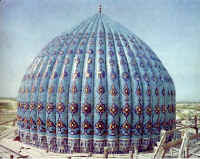
The mosque is located in the north-west corner of the building. The premises is covered by the dome, placed high on the drum having the light apertures. The mosque is the only premises of the monument, where the fragments of wall paintings survived. These paintings were made with light blue paints and presenting geometric and vegetable ornaments embraced into belts and frames. The mosque mikhrab that was made using the techniques of the composed glazed mosaic is considered to be the unique monument of the mosaic art.
The bounding link of all premises - is jamaatkhana - the main premises of the complex, square, with sides equal to 18.2 meters; it is covered by the spheric-conic dome with an ordinary envelope, the largest one among all survived domes in Central Asia. Here the meetings and group zeals (zikras) of dervishes were hold. In the centre of the hall there is a ritual cauldron (kazan; therefore another, more preferable
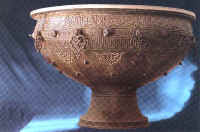 name of the hall is kazanlyk). According to the legend, this cauldron was founded from the alloy of seven metals. The cauldron is a symbol of hospitality and unity. Its diameter is 2.2 m., the weight is 2 tons. Exaggerated size of the cauldron may be explained by the beliefs of ancient Turkic tribes: the edge of the cauldron is to be at the mouth level of a person coming to it. The cauldron surface is decorated with three belts of relief inscriptions on the background of vegetable ornament. The upper inscription reads that this cauldron for water - is the Timur's donation to the building erected in commemoration of Khodja Akhmed Yasawi. The wording of the middle inscription is "Be blessed", the year the cauldron was made (1399), and the master's name - Abdulgaziz ibn Sharafutdin from Tebriz. The lower inscription is "The Kingdom Glory to Allah". The handles of the cauldron are lotus shaped and take turns with round ledges.
name of the hall is kazanlyk). According to the legend, this cauldron was founded from the alloy of seven metals. The cauldron is a symbol of hospitality and unity. Its diameter is 2.2 m., the weight is 2 tons. Exaggerated size of the cauldron may be explained by the beliefs of ancient Turkic tribes: the edge of the cauldron is to be at the mouth level of a person coming to it. The cauldron surface is decorated with three belts of relief inscriptions on the background of vegetable ornament. The upper inscription reads that this cauldron for water - is the Timur's donation to the building erected in commemoration of Khodja Akhmed Yasawi. The wording of the middle inscription is "Be blessed", the year the cauldron was made (1399), and the master's name - Abdulgaziz ibn Sharafutdin from Tebriz. The lower inscription is "The Kingdom Glory to Allah". The handles of the cauldron are lotus shaped and take turns with round ledges.
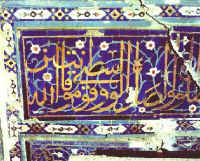 Thanks to polychromic glazed incrustations, turquoise tints, that entirely cover the facades, the building looks very nice. The ornament is mainly epigraphic. All walls of the monument are covered with religious texts often included into geometric nettings - girikhs. The texts from Koran are placed on under-dome friezes and written by the canonical hand-writing "suls"; on the monument khadises, used in design of doorways and window openings are specially emphasised. Carpet fillings of the walls with stylised letters contain the most common theological maxims. The only facade of khanaka remained unfretted is the southern or the main facade of the building designed as a giant portal.
Thanks to polychromic glazed incrustations, turquoise tints, that entirely cover the facades, the building looks very nice. The ornament is mainly epigraphic. All walls of the monument are covered with religious texts often included into geometric nettings - girikhs. The texts from Koran are placed on under-dome friezes and written by the canonical hand-writing "suls"; on the monument khadises, used in design of doorways and window openings are specially emphasised. Carpet fillings of the walls with stylised letters contain the most common theological maxims. The only facade of khanaka remained unfretted is the southern or the main facade of the building designed as a giant portal.
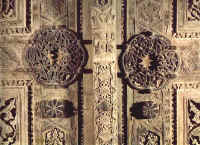 The Turkistan khanaka is a complex engineering construction. The immense size of the building with two tiers of windows, and two and even three tiers of rooms predetermined refined and complicated constructive solutions. The foundations of the monument are clay layers at the depth up to 1.5 m., served also for hydroisolation of the walls. The most loaded parts of the monument are the portal pylons, jamaatkhana basis rests upon wattle and daub foundations. The walls are built of the square baked bricks with usage of ganch grout (a kind of gypsum).
The Turkistan khanaka is a complex engineering construction. The immense size of the building with two tiers of windows, and two and even three tiers of rooms predetermined refined and complicated constructive solutions. The foundations of the monument are clay layers at the depth up to 1.5 m., served also for hydroisolation of the walls. The most loaded parts of the monument are the portal pylons, jamaatkhana basis rests upon wattle and daub foundations. The walls are built of the square baked bricks with usage of ganch grout (a kind of gypsum).
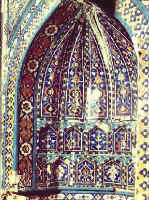 The khanaka of Akhmed Yasawi played a major role in creation of the Turkistan necropolis developed on the place of the early medieval cemetery, consisting of several over-grave constructions and mausoleums with a traditional orientation of entrances to south-west - to Mecca. Building of the khanaka influenced the appearance of further burials of Khans near it. Thus, at the end of the XV century in Turkistan the mausoleum of Rabi'i Sultan Begim - the daughter of the famous Timurid Ulugbek, and wife of Khan Abulkhair was constructed. Afterwards, the mausoleums of Esim khan, Ablai khan, Djangir khan and others were constructed near the khanaka of Khodja Akhmed Yasawi. Few burials were made inside the khanaka, but considerably later. According to the Muslim beliefs, the burial near the grave of the saint promised his protection in next world, so there was a great amount of people willing to be buried closer to the mausoleum.
The khanaka of Akhmed Yasawi played a major role in creation of the Turkistan necropolis developed on the place of the early medieval cemetery, consisting of several over-grave constructions and mausoleums with a traditional orientation of entrances to south-west - to Mecca. Building of the khanaka influenced the appearance of further burials of Khans near it. Thus, at the end of the XV century in Turkistan the mausoleum of Rabi'i Sultan Begim - the daughter of the famous Timurid Ulugbek, and wife of Khan Abulkhair was constructed. Afterwards, the mausoleums of Esim khan, Ablai khan, Djangir khan and others were constructed near the khanaka of Khodja Akhmed Yasawi. Few burials were made inside the khanaka, but considerably later. According to the Muslim beliefs, the burial near the grave of the saint promised his protection in next world, so there was a great amount of people willing to be buried closer to the mausoleum.
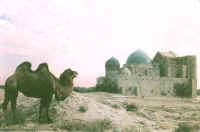 The khanaka of Akhmed Yasawi is one of the unique architectural constructions on the territory of Kazakhstan. The scientific investigation of the khanaka started at the end of the XIX century, though the descriptions of this building are met in various sources, beginning from the XV century. The first scientific expedition to the town of Turkistan was undertaken in 1905 - it was arranged by the Russian Committee for researches of Central and East Asia and headed by professor N.I. Veselovsky. The aim of this expedition was to make drafts of the monument. Beginning from 1922, several commissions took part in the technical investigation of the building. The most important investigations of the monument were made in 1952 - 1958 (B.N. Zasypkin, T.Sh. Karumidze, L.Yu. Menkovskaya, K.A. Shakhurin) and also in 1970-1980 (B.T. Tuyakbaeva, A.N. Proskurin).
The khanaka of Akhmed Yasawi is one of the unique architectural constructions on the territory of Kazakhstan. The scientific investigation of the khanaka started at the end of the XIX century, though the descriptions of this building are met in various sources, beginning from the XV century. The first scientific expedition to the town of Turkistan was undertaken in 1905 - it was arranged by the Russian Committee for researches of Central and East Asia and headed by professor N.I. Veselovsky. The aim of this expedition was to make drafts of the monument. Beginning from 1922, several commissions took part in the technical investigation of the building. The most important investigations of the monument were made in 1952 - 1958 (B.N. Zasypkin, T.Sh. Karumidze, L.Yu. Menkovskaya, K.A. Shakhurin) and also in 1970-1980 (B.T. Tuyakbaeva, A.N. Proskurin).